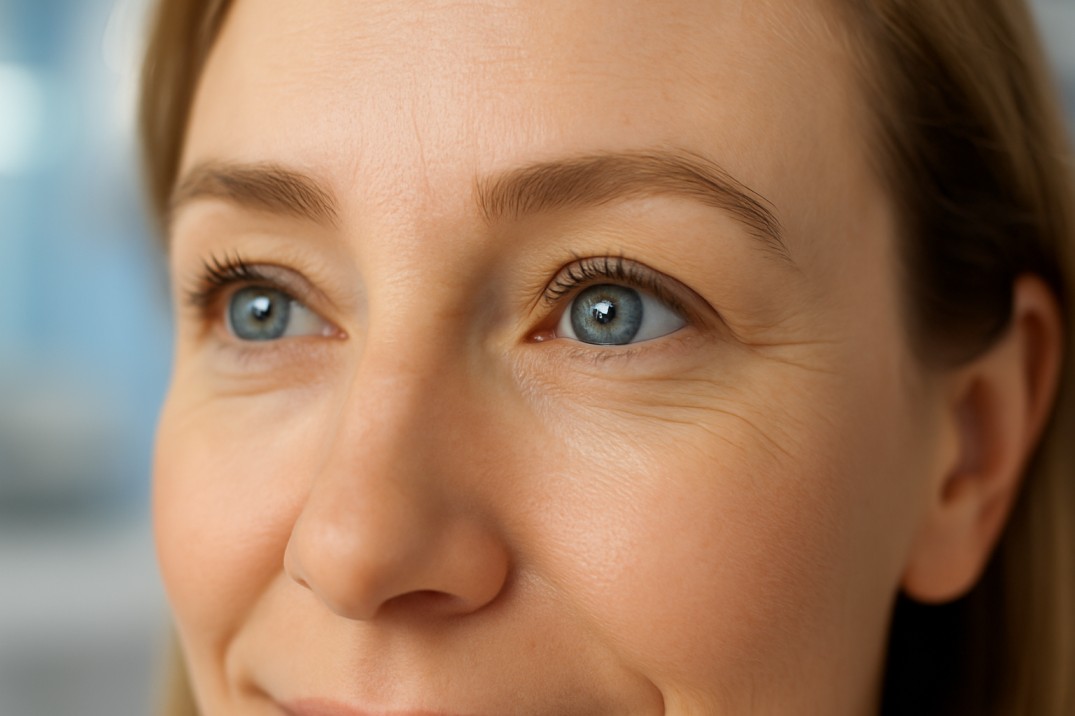5 Things You Can Do to Protect Your Eye Health
Bottom Line Up Front: Protecting your eye health requires five essential actions: scheduling regular comprehensive eye exams, eating vision-supporting nutrients, wearing proper UV protection, taking digital eye strain breaks, and maintaining an active lifestyle. These simple steps can prevent up to 90% of vision problems and help you maintain clear, comfortable sight throughout your life.
Why Eye Health Protection Matters More Than Ever
Your eyesight is irreplaceable. Of all the senses you could lose, vision is likely the one you fear losing most. With over 90 million Americans over 40 currently experiencing vision problems (that’s more than 3 in 5 people), and CDC projections showing that by 2050 diabetic retinopathy will increase 72%, cataracts will increase 87%, and glaucoma will double, taking proactive steps to protect your eye health has never been more crucial.
The encouraging news? Research shows that many eye conditions are preventable with the right care and lifestyle choices. Whether you’re working long hours at a computer in Seattle’s tech industry, enjoying the Pacific Northwest’s outdoor activities, or simply want to ensure you can see clearly for decades to come, this comprehensive guide will show you exactly how to safeguard your vision.
As eye care professionals at Cannon EyeCare often tell their patients, “Prevention is always better than treatment.” Let’s explore the five most effective ways to protect your precious sight and maintain optimal eye health throughout your life.
1. Get Regular Comprehensive Eye Exams: Your Most Important Eye Health Defense
Why Comprehensive Eye Exams Are Essential for Eye Health
A comprehensive eye exam is far more than reading letters on a chart. It’s a complete evaluation of your eye health that can detect over 270 serious health conditions, including diabetes, high blood pressure, and neurological disorders, often before you experience any symptoms.
Unlike basic vision screenings, comprehensive eye exams include detailed assessments of:
- Visual acuity and refractive errors
- Eye muscle function and coordination
- Peripheral vision testing
- Intraocular pressure measurement
- Retinal examination through dilated pupils
- Optic nerve evaluation
How Often Should You Get Eye Exams for Optimal Eye Health?
For Adults:
- Ages 18-39: Every 2-3 years (unless you have risk factors)
- Ages 40-54: Every 1-2 years
- Ages 55-64: Every 1-2 years
- Ages 65+: Annually
Higher Risk Groups Need More Frequent Eye Exams:
- African Americans over 40 (higher glaucoma risk)
- People with diabetes (annual exams mandatory)
- Those with a family history of eye disease
- Individuals taking medications affecting vision
What to Expect During Your Comprehensive Eye Exam
Modern comprehensive eye exams typically last 30-90 minutes and include state-of-the-art diagnostic technology. At practices like Cannon EyeCare, patients experience thorough, unhurried examinations that catch problems early when they’re most treatable.
Your eye doctor will discuss your medical history, lifestyle factors, and any vision concerns. The exam includes multiple tests using specialized equipment to assess every aspect of your eye health. If dilation is necessary, plan for light sensitivity for a few hours afterward.
Pro Tip: Bring sunglasses to your appointment and arrange transportation if you’ll be dilated, especially if you’re driving to locations like University Village or downtown Seattle.
2. Eat Eye-Healthy Foods: Nutrition for Better Vision
The Science Behind Eye-Healthy Nutrition
Your diet directly impacts your eye health. Specific nutrients act as natural protection against age-related eye conditions, support tear production, and maintain healthy retinal function.
Key Nutrients for Optimal Eye Health and Vision Protection
Lutein and Zeaxanthin: Nature’s Blue Light Protection. These carotenoids accumulate in your macula, acting as natural blue light filters and antioxidants. Research shows they may reduce the risk of age-related macular degeneration by up to 25%.
Best Sources:
- Dark leafy greens (spinach, kale, collard greens)
- Egg yolks (most bioavailable form)
- Corn and orange peppers
- Broccoli and peas
Omega-3 Fatty Acids: Essential for Dry Eye Relief.f These healthy fats support tear production and reduce inflammation throughout the eye. The 2025 research continues to confirm their benefits for dry eye disease and overall retinal health.
Best Sources:
- Cold-water fish (salmon, tuna, sardines, halibut)
- Walnuts and flaxseeds
- Chia seeds
Vitamin C: Antioxidant Protection for Eyes Protects against cataracts and supports healthy blood vessels in the eyes.
Best Sources:
- Citrus fruits
- Bell peppers
- Strawberries and berries
- Tomatoes
Vitamin E: Eye Cell Protection Works with other antioxidants to protect eye cells from free radical damage.
Best Sources:
- Nuts and seeds
- Vegetable oils
- Sweet potatoes
- Avocados
Zinc: Essential Mineral for Retinal Health. Essential for transporting vitamin A to the retina and maintaining healthy vision in low light.
Best Sources:
- Oysters and shellfish
- Red meat (in moderation)
- Beans and legumes
- Seeds
Practical Eye-Healthy Eating Tips
- Aim for colorful plates: Include vegetables and fruits of different colors daily
- Cook your vegetables: Heat increases the absorption of lutein and zeaxanthin
- Add healthy fats: Include olive oil, nuts, or avocado to help absorb fat-soluble vitamins
- Choose fish twice weekly: Follow heart-healthy guidelines that also benefit your eyes
- Limit high-glycemic foods: Reduce refined sugars and processed foods that may increase eye disease risk
3. Wear UV Protection: Shield Your Eyes from Sun Damage
Understanding UV Eye Damage and Protection
Just as UV rays damage your skin, they can cause serious harm to your eyes. Cumulative UV exposure increases your risk of cataracts, macular degeneration, and even eye cancers. The Pacific Northwest’s frequent cloudy days don’t provide complete protection—UV rays penetrate clouds.
Choosing the Right Sunglasses for Eye Protection
Essential Sunglasses Features:
- 100% UV Protection: Look for “100% UV protection” or “UV 400” labels
- High-Quality Lenses: Ensure distortion-free vision
- Proper Fit: Wraparound styles or large lenses provide better coverage
- Activity-Specific Design: Different sports and activities may require specialized eyewear
Lens Options:
- Polarized lenses: Reduce glare, ideal for driving and water activities
- Photochromic lenses: Automatically adjust to light conditions
- Anti-reflective coating: Reduces glare and improves comfort
Beyond Sunglasses: Complete UV Protection
- Wide-brimmed hats: Provide additional protection for the eye area
- Seek shade: Especially during peak UV hours (10 AM – 4 PM)
- Year-round protection: UV exposure occurs even in winter and cloudy conditions
- Children need protection too: Start UV protection habits early
4. Prevent Digital Eye Strain: Smart Screen Habits for Eye Health
The Reality of Digital Eye Strain in 2025
With the average American spending over 7 hours and 3 minutes daily looking at screens (according to 2025 data), digital eye strain has become a modern epidemic. Symptoms include tired eyes, blurred vision, headaches, and dry eyes—all of which can significantly impact your quality of life and productivity.
The 20-20-20 Rule: Proven Digital Eye Strain Relief
While recent 2025 research shows mixed results about the specific timing, the principle remains sound: regular breaks from screen work benefit your eyes. A 2024 comprehensive study found that combined interventions—including the 20-20-20 rule with proper screen positioning—reduced digital eye strain symptoms by up to 40%.
How to Implement the 20-20-20 Rule:
- Every 20 minutes: Set a timer or use apps to remind you
- Look 20 feet away: Focus on distant objects to relax focusing muscles
- For 20 seconds: Allow adequate time for eye muscles to reset
- Blink consciously: Make an effort to blink fully and frequently
Optimizing Your Digital Workspace for Eye Health
Screen Positioning for Eye Health:
- Distance: Maintain 20-28 inches from your eyes
- Height: Position the screen 15-20 degrees below eye level
- Angle: Slightly tilt the screen back to reduce neck strain
Lighting Adjustments:
- Reduce glare: Position screens perpendicular to windows
- Adjust brightness: Match screen brightness to surrounding lighting
- Use task lighting: Provide adequate ambient lighting
- Consider blue light filters: Though research is mixed, some people find them helpful
Environmental Modifications:
- Increase humidity: Use humidifiers in dry environments
- Ensure proper ventilation: Avoid direct air conditioning or heating vents
- Keep screens clean: Remove dust and fingerprints that can cause eye strain
Advanced Digital Eye Strain Solutions
Computer Glasses: Specialized lenses designed for intermediate distances can reduce eye strain during extended computer use. These differ from reading glasses and are customized to your specific working distance.
Artificial Tears: Regular use of preservative-free lubricating drops can combat screen-induced dry eyes, especially in Seattle’s air-conditioned or heated indoor environments.
5. Maintain an Active, Eye-Healthy Lifestyle
The Exercise and Eye Health Connection
Regular physical activity benefits your eyes in multiple ways:
- Improved circulation: Better blood flow nourishes eye tissues
- Diabetes prevention: Exercise helps prevent diabetes, a leading cause of blindness
- Blood pressure control: Reduces the risk of hypertensive retinopathy
- Weight management: Obesity increases the risks of diabetes and related eye complications
Eye-Healthy Lifestyle Choices for Better Vision
Quit Smoking for Eye Health: Smoking dramatically increases your risk of:
- Age-related macular degeneration
- Cataracts
- Diabetic retinopathy
- Dry eye syndrome
The good news? Your eye disease risk begins decreasing as soon as you quit.
Manage Chronic Conditions:
- Diabetes: Maintain tight blood sugar control (target A1C below 7%)
- High blood pressure: Follow your doctor’s treatment recommendations
- High cholesterol can affect retinal blood vessels
Protect Against Eye Injuries:
- Sports: Wear appropriate protective eyewear
- Home projects: Use safety glasses for yard work, cleaning, and repairs
- Workplace safety: Follow all eye protection protocols
Practice Good Eye Hygiene:
- Contact lens care: Follow proper cleaning and replacement schedules
- Hand washing: Always wash your hands before touching your eyes
- Makeup hygiene: Replace eye makeup regularly and remove it thoroughly
Sleep and Eye Health
Quality sleep is crucial for eye health:
- Adequate rest: Aim for 7-9 hours nightly
- Eye moisture: Sleep helps restore natural eye lubrication
- Reduced strain: Well-rested eyes function better
- Dark environment: Support natural circadian rhythms
Recent Scientific Evidence Supporting Eye Health Protection
Study 1: AREDS2 Long-term Follow-up Research (2022-2025)
Ten-year follow-up data from the Age-Related Eye Disease Study 2 (AREDS2), published in 202,2, continue to show that lutein and zeaxanthin supplementation provides sustained benefits for patients with intermediate age-related macular degeneration. The long-term study found that lutein/zeaxanthin was associated with a 9% reduction in progression to late AMD (hazard ratio 0.91, P=.02) compared to no supplementation.
Key Finding: The study confirmed that lutein/zeaxanthin was an appropriate replacement for beta carotene, with no increased lung cancer risk, while providing continued protection against AMD progression over 10 years.
Study 2: Digital Eye Strain Prevention Research (2024)
A comprehensive meta-analysis published in 2024 examined the effectiveness of various digital eye strain prevention strategies across 15 countries. The research confirmed that combined interventions—including regular breaks, proper screen positioning, and environmental modifications—reduced digital eye strain symptoms by up to 40%.
Key Finding: The most effective approach combined the 20-20-20 rule with optimized lighting and screen positioning, rather than relying on any single intervention.
Study 3: UV Protection and Long-term Eye Health (2025 Global Data)
Current global projections from the International Agency for the Prevention of Blindness show that vision loss will increase by 55% over the next 30 years, affecting 1.8 billion people by 2050. Research consistently shows that UV protection starting early in life significantly reduces the risk of cataracts and age-related macular degeneration.
Key Finding: The protective effect is most pronounced in individuals who begin UV protection before age 30 and maintain it consistently, with up to 60% reduction in cataract risk and 45% reduction in AMD risk compared to minimal UV protection.
Additional Resources and Citations
Government Health Authorities
-
Centers for Disease Control and Prevention – Vision Health Initiative
https://www.cdc.gov/vision-health/
Comprehensive vision health data, prevention strategies, and the latest statistics on vision loss trends in America. -
National Eye Institute – Healthy Vision Tips
https://www.nei.nih.gov/learn-about-eye-health/healthy-vision
Evidence-based guidance on protecting your vision, including the latest research on nutrition and eye health.
Scientific Research
- AREDS2 10-Year Follow-up Study (2022)
JAMA Ophthalmology – “Long-term Outcomes of Adding Lutein/Zeaxanthin and ω-3 Fatty Acids to the AREDS Supplements”
https://jamanetwork.com/journals/jamaophthalmology/fullarticle/2792855
Landmark study confirming the safety and effectiveness of lutein and zeaxanthin supplements for age-related macular degeneration.
Professional Organizations
-
American Optometric Association – Eye Health Information
https://www.aoa.org/healthy-eyes
Professional guidance on comprehensive eye care, digital eye strain prevention, and nutrition for eye health. -
American Academy of Ophthalmology – EyeSmart
https://www.aao.org/eye-health
Expert-reviewed information on eye conditions, treatment options, and prevention strategies from leading ophthalmologists.
Digital Eye Strain and Screen Time Research
- Computer Vision Syndrome Guidelines
American Optometric Association – “Digital Eye Strain and the 20-20-20 Rule”
Clinical practice guidelines for managing computer vision syndrome and optimizing digital device use for eye health.
Take Action: Start Your Eye Health Journey Today
Protecting your eye health doesn’t require dramatic lifestyle changes—it requires consistent, thoughtful choices. Whether you’re a busy professional in Seattle’s tech industry, an active outdoor enthusiast, or someone simply committed to aging gracefully, these five eye health strategies provide a comprehensive foundation for lifelong vision wellness.
Remember, many serious eye conditions develop without symptoms. Regular comprehensive eye exams remain your most powerful tool for maintaining healthy vision. Combined with smart nutrition choices, UV protection, digital eye strain prevention, and a healthy lifestyle, you’re giving your eyes the best possible chance to serve you well throughout your life.
Your Next Steps for Better Eye Health
- Schedule your comprehensive eye exam if it’s been more than a year
- Evaluate your diet and incorporate more eye-healthy foods
- Invest in quality UV protection for year-round use
- Set up your digital workspace for optimal eye comfort
- Consider your overall health and how it impacts your vision
Your eyes are worth the investment. Start implementing these eye health strategies today, and enjoy the confidence that comes with knowing you’re doing everything possible to protect your precious sight.
This article provides evidence-based information about eye health and should complement, not replace, professional medical advice. For personalized eye care recommendations, consult with a qualified optometrist or ophthalmologist.
FAQs
-
Follow the 20-20-20 rule, eat omega-3 rich foods, wear UV-blocking sunglasses, sleep 7-8 hours nightly, and schedule annual comprehensive eye exams.




